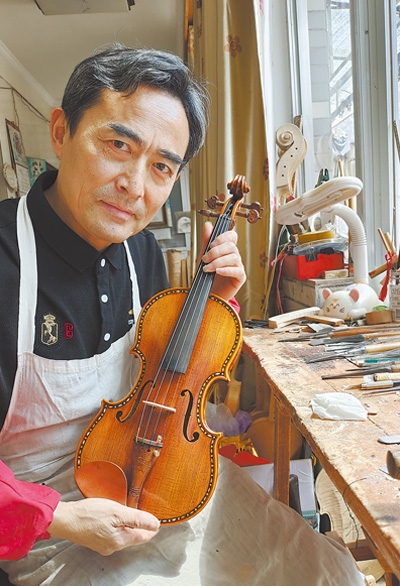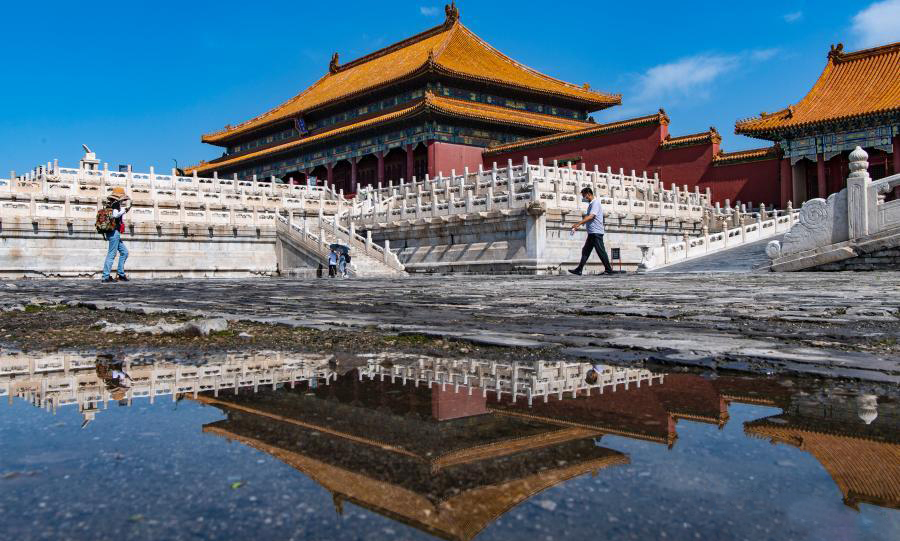Township in E China’s Jiangsu gains international reputation thanks to decades of accumulated experience in violin manufacturing

Photo shows violin maker Lyu Guanbao holding a violin in his hands. (Photo/Lyu Yifei)
Huangqiao township in Taixing city, east China’s Jiangsu Province has been dubbed “China’s violin production base.” Sixty years ago, it produced violin parts for manufacturers in Shanghai, and nowadays, it has emerged as a major violin production base that enjoys an international reputation.
Huangqiao accounts for 70 percent of China’s total violin production and over 50 percent of the world’s total violin production. Every year, about 700,000 guitars are also produced there. There are over 230 enterprises linked to violin manufacturing in Huangqiao, and of the township’s total population of over 200,000, more than 30,000 local residents are engaged in violin manufacturing.
In 1962, two workers from the Shanghai Violin Factory returned to Huangqiao township and started to teach violin manufacturing skills to locals. In those days, a person could earn 0.5 yuan ($0.074) by carving a violin head, a salary that enabled workers to support their families during a time when everyone was living a difficult life.
In 1971, a musical instrument factory was established in a township near Huangqiao, which served as a supplier of violin parts for manufacturers in Shanghai. Li Shu, as a young man, came to the factory the next year and became an apprentice. Li mastered the skills after two months of diligent learning. Normally, it would take a worker half a year to become a skilled worker.
In 1980, Li was promoted to become a head of the factory in charge of manufacturing. Li bought a violin and started to think about how to make more money by manufacturing a completely assembled violin, instead of just producing the violin parts as a supplier. In 1983, Li became head of the factory. To improve the operations of the factory, which was in debt at that time, Li contacted the Shanghai Violin Factory and expressed his hope to begin manufacturing violins at the factory. He also said that his factory could reduce the costs associated with making a violin by two thirds.
In 1985, the musical instrument factory near Huangqiao became a branch factory of the Shanghai Violin Factory, and the two signed a 10-year contract. The sales volume of the branch factory exceeded 2 million yuan that year, and the profit was more than 300,000 yuan. Seeing this, local farmers started to actively join the factory. As the industry prospered, the incomes of local farmers who were involved in the trade increased as well.
While producing violins, the people of Huangqiao township were able to demonstrate their diligence and hardworking spirit. They even worked during their off-duty hours in an effort to skillfully master the techniques.
In 1995, the violin factory became an independent factory. In the same year, the factory produced over 60,000 violins, outpacing some of the best violin manufacturers in Shanghai and Guangzhou and becoming the biggest violin producer in the country.
During this time, the factory also started to embrace the international market.
In 1992, Li went to Frankfurt, Germany, to participate in an international musical instrument exposition. He brought a violin made by his factory, but in the end he didn’t show it off because he discovered that the violins made by foreign manufacturers were of super quality compared with his product, fearing that his Chinese-made violin would be overshadowed by the foreign ones. After the expo, Li brought home some violins made by foreign manufacturers for staff members at his factory to learn the various manufacturing techniques and other details that had been adopted in their manufacturing.
When Li participated in another international musical instrument expo, he confidently introduced his violin to various producers and told them that the product was priced at just $15, and it could meanwhile generate a profit margin that was between 30 to 40 percent of the product’s final price. The violin from Huangqiao township impressed those in attendance at the global musical instrument expo.
In 1995, the Finelegend Musical Instruments Co., Ltd. was established as a Chinese-foreign joint venture.
By embracing international cooperation, the company was able to sell half of its products to markets in the U.S. and Europe. Meanwhile, international standards for violin manufacturing were introduced to and adopted by the company.
At the peak of its production capacity, the Finelegend Musical Instruments Co., Ltd. had more than 1,100 staff members, who could produce over 300,000 violins in one year. Some British companies even set up their own violin factories in Huangqiao township.
At an international violin manufacturing competition held in China in 2010, violin makers from Huangqiao were astonished by the price gap between a home-made violin and an imported one. Made from the same raw materials and using the same techniques, the asking price for a violin made in Huangqiao was just over 1,000 yuan, while an imported violin might typically sell for at least 2,000 euros.
Wu Jianxin, head of a violin company in Huangqiao, believes that it is necessary that violins used for performance purposes should be made to become akin to works of fine art, which are otherwise quite expensive and with the number produced being comparatively small. However, although the violins used by learners are still products that are bought and sold, they generate fewer profits despite the violins being produced at a massive scale.
To capture shares of the medium and high-end market segments, Wu’s company produces over 20,000 high-end violins a year and gradually has built stable sales channels in the U.K. and the U.S., with the violin brand earning a good reputation in local markets.
Xu Xiaofeng, a native in Huangqiao, is a young craftsman of violin manufacturing. He has been engaged in the business for over one decade and is a well-known violin maker in the industry. The violins made by Xu are widely applauded for their exquisite manufacturing details, and one violin made by Xu was once sold for hundreds of thousands of yuan at an auction. Xu could have run a profitable business of his own by opening a workshop in first-tier cities in China or in major cities abroad. However, the man finally chose to go back to his hometown instead in order to lend a helping hand with industrial upgrading there.
Xu opened a workshop with the Jiangsu Finelegend Musical Instrument Group, teaching the skills he picked up over the years to a younger generation of workers, all of them working hand-in-hand to pass on the craft while incorporating the latest innovations.
Photos
Related Stories
- Participants compete online at Shanghai int'l violin contest
- Small Chinese county becomes international player in violin production
- Violinist lifts cast of young talent
- National Youth Violin Contest kicks off in Qingdao [Video]
- Slovenian violin concert builds cultural bridge
- Raising the bow
- China's 'Music Valley' to settle in Beijing's Pinggu District
- Tibetan girl's violin hobby
Copyright © 2022 People's Daily Online. All Rights Reserved.









